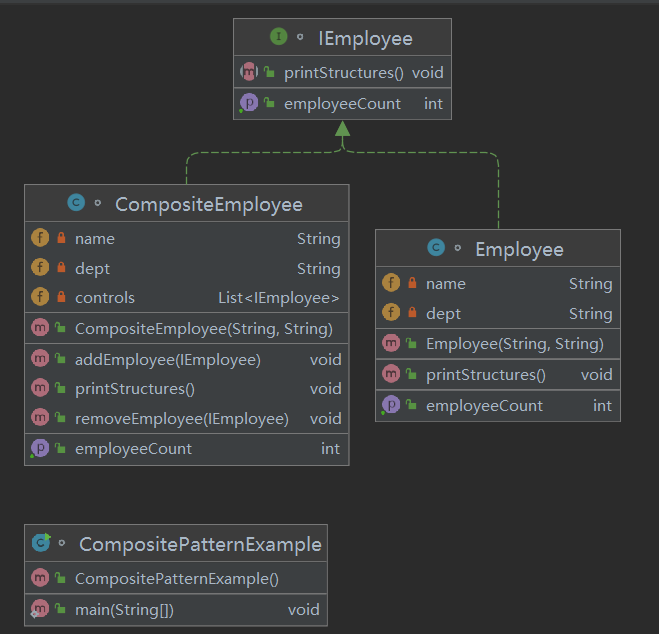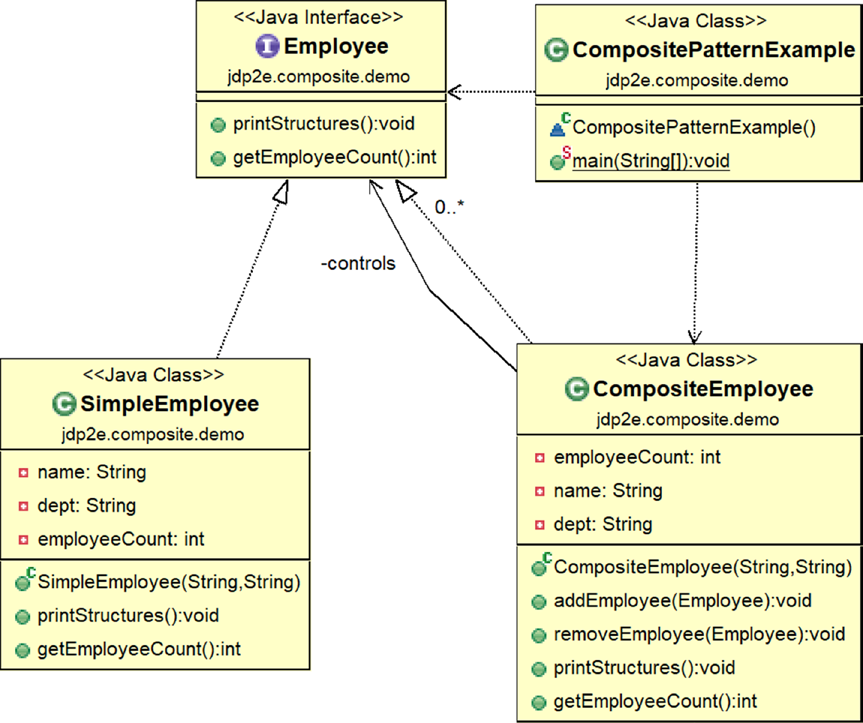11-Composite Pattern
1,定义¶
| 官方的 | 是用于把一组相似的对象当作一个单一的对象。组合模式依据树形结构来组合对象,用来表示部分以及整体层次。这种类型的设计模式属于结构型模式,它创建了对象组的树形结构。 |
|---|---|
| 通俗的 | java中的组合是指:在A类里定义一个B类的引用,A拥有了B,叫组合。 只是单纯的组合而已,而不是一种设计模式。 组合和组合模式不是一回事! 基本上见到的树形结构都使用到了组合模式。 |
2,各类含义,UML¶
 组合模式中有几个核心的部分:
组合模式中有几个核心的部分:
Leaf(叶子):表示该节点下面没有其他子节点了,就称为叶子 Compostie(容器构件):容器构件,该节点下还有其他子节点,理解为一个容器,里面包含了其他子节点。就叫做容器构件 Component(抽象构件):抽象构件中定义了叶子和容器构件的共同点。比如,有公共的添加删除叶子功能,有显示节点功能。
3,代码¶
|  |  |
|---|

import java.util.ArrayList; import java.util.List; class CompositeEmployee implements IEmployee { //private static int employeeCount=0; private int employeeCount=0; private String name; private String dept; //The container for child objects private List<IEmployee> controls; //Constructor public CompositeEmployee(String name, String dept) { this.name = name; this.dept = dept; controls = new ArrayList<IEmployee>(); } public void addEmployee(IEmployee e) { controls.add(e); } public void removeEmployee(IEmployee e) { controls.remove(e); } @Override public void printStructures() { System.out.println("\t" + this.name + " works in " + this.dept); for(IEmployee e: controls) { e.printStructures(); } } @Override public int getEmployeeCount() { employeeCount=controls.size(); for(IEmployee e: controls) { employeeCount+=e.getEmployeeCount(); } return employeeCount; } } |
|---|
|
class CompositePatternExample { /**Principal is on top of college. *HOD -Maths and Comp. Sc directly reports to him *Teachers of Computer Sc. directly reports to HOD-CSE *Teachers of Mathematics directly reports to HOD-Maths */ public static void main(String[] args) { System.out.println("***Composite Pattern Demo ***"); //2 teachers other than HOD works in Mathematics department Employee mathTeacher1 = new Employee("Math Teacher-1","Maths"); Employee mathTeacher2 = new Employee("Math Teacher-2","Maths"); //teachers other than HOD works in Computer Sc. Department Employee cseTeacher1 = new Employee("CSE Teacher-1", "Computer Sc."); Employee cseTeacher2 = new Employee("CSE Teacher-2", "Computer Sc."); Employee cseTeacher3 = new Employee("CSE Teacher-3", "Computer Sc."); //The College has 2 Head of Departments-One from Mathematics, One //from Computer Sc. CompositeEmployee hodMaths = new CompositeEmployee("Mrs.S.Das(HOD-Maths)","Maths"); CompositeEmployee hodCompSc = new CompositeEmployee("Mr. V.Sarcar(HOD-CSE)", "Computer Sc."); //Principal of the college CompositeEmployee principal = new CompositeEmployee("Dr.S.Som (Principal)","Planning-Supervising-Managing"); //Teachers of Mathematics directly reports to HOD-Maths hodMaths.addEmployee(mathTeacher1); hodMaths.addEmployee(mathTeacher2); //Teachers of Computer Sc. directly reports to HOD-CSE hodCompSc.addEmployee(cseTeacher1); hodCompSc.addEmployee(cseTeacher2); hodCompSc.addEmployee(cseTeacher3); /*Principal is on top of college.HOD -Maths and Comp. Sc directly reports to him*/ principal.addEmployee(hodMaths); principal.addEmployee(hodCompSc); /*Printing the leaf-nodes and branches in the same way i.e. in each case, we are calling PrintStructures() method */ System.out.println("\n Testing the structure of a Principal object"); //Prints the complete structure principal.printStructures(); System.out.println("At present Principal has control over "+ principal.getEmployeeCount()+ " number of employees."); System.out.println("\n Testing the structure of a HOD-CSE object:"); //Prints the details of Computer Sc, department hodCompSc.printStructures(); System.out.println("At present HOD-CSE has control over "+ hodCompSc.getEmployeeCount()+ " number of employees."); System.out.println("\n Testing the structure of a HOD-Maths object:"); //Prints the details of Mathematics department hodMaths.printStructures(); System.out.println("At present HOD-Maths has control over "+ hodMaths.getEmployeeCount()+ " number of employees."); //Leaf node System.out.println("\n Testing the structure of a leaf node:"); mathTeacher1.printStructures(); System.out.println("At present Math Teacher-1 has control over "+ mathTeacher1.getEmployeeCount()+ " number of employees."); /*Suppose, one computer teacher is leaving now from the organization*/ hodCompSc.removeEmployee(cseTeacher2); System.out.println("\n After CSE Teacher-2 resigned, the organization has following members:"); principal.printStructures(); System.out.println("At present Principal has control over "+ principal.getEmployeeCount()+ " number of employees"); System.out.println("At present HOD-CSE has control over "+ hodCompSc.getEmployeeCount()+ " number of employees"); System.out.println("At present HOD-Maths has control over "+ hodMaths.getEmployeeCount()+ " number of employees"); } } |
|---|
***Composite Pattern Demo *** Testing the structure of a Principal object
At present Principal has control over 7 number of employees. Testing the structure of a HOD-CSE object:
At present HOD-CSE has control over 3 number of employees. Testing the structure of a HOD-Maths object:
At present HOD-Maths has control over 2 number of employees. Testing the structure of a leaf node:
At present Math Teacher-1 has control over 0 number of employees. After CSE Teacher-2 resigned, the organization has following members:
At present Principal has control over 6 number of employees At present HOD-CSE has control over 2 number of employees At present HOD-Maths has control over 2 number of employees |
|---|
4,优缺点¶
优点: 1、高层模块调用简单。 2、节点自由增加。
缺点:在使用组合模式时,其叶子和树枝的声明都是实现类,而不是接口,违反了依赖倒置原则。 “依赖倒置原则(Dependence Inversion Principle)是程序要依赖于抽象接口,不要依赖于具体实现。简单的说就是要求对抽象进行编程,不要对实现进行编程,这样就降低了客户与实现模块间的耦合。
5,适用场景¶
部分、整体场景,如树形菜单,文件、文件夹的管理。
